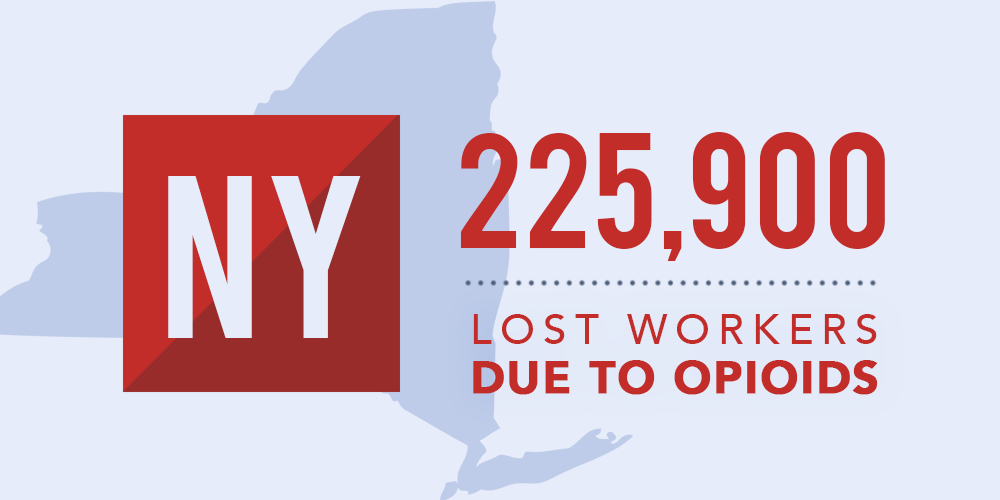September 12, 2018
New York

New York’s labor market is among the hardest hit by the opioid crisis in the whole country. Between 1999 and 2015, the volume of prescription opioids per capita in New York rose 871 percent, or about 15 percent annually. This rise in opioid use in New York was associated with a 2.9 percentage point decline in the state’s labor force participation rate of prime-age workers, slowing annual real gross domestic product (GDP) growth by 0.8 percentage points.
Labor Force Participation
Table NY-1 contains the change in the prime-age labor force participation rate due to opioids between 1999 and 2015, and the resulting number of workers absent from the labor force as of 2015.
Table NY-1: Impact of Opioids on Prime-Age Labor Force Participation, 1999-2015
| Gender | Prime-Age Labor Force Participation Rate, 1999-2015 (in percentage points) | Workers, 2015 (in thousands)* |
| Total |
-2.9 |
-225.9 |
| Men |
-2.5 |
-96.2 |
| Women |
-3.2 |
-129.6 |
| *Estimates for each gender may not add to total due to rounding. | ||
The rise in opioid prescriptions from 1999 to 2015 led the labor force participation rate for both prime-age men and women to decline substantially. Opioids lowered the participation rates of prime-age men and women by 2.5 percentage points and 3.2 percentage points, respectively. For perspective, opioids decreased nationwide labor force participation rates of prime-age men and women by 1.4 percentage points and 1.8 percentage points, respectively.
The decline in the prime-age male labor force participation rate in New York means that in 2015 96,200 men were absent from the labor force due to opioids. The steeper decline in prime-age female labor force participation means that even more women were absent from the labor force. In 2015, opioids kept 129,600 women in New York out of the labor force. Together, the growth in per capita prescription opioids from 1999 to 2015 caused the total prime-age labor force participation rate in New York to decline by 2.9 percentage points. That translates to a loss of 225,900 workers as of 2015, the most among the states.
Work Hours
From 1999 to 2015, the rise in opioid dependency and resulting decline in prime-age labor force participation cumulatively cost New York’s economy over 3 billion work hours. Table NY-2 contains the cumulative loss of work hours associated with New York’s decline in labor force participation.
Table NY-2: Impact of Opioids on Work Hours, 1999-2015
| Gender | Work Hours, Cumulative 1999-2015 (in millions) |
| Total |
-3,077 |
| Men |
-1,313 |
| Women |
-1,764 |
As the number of individuals absent from the labor force due to opioids grew, New York’s economy lost an increasing number of work hours. Between 1999 and 2015, New York cumulatively lost a total of 3.1 billion work hours. Since opioid dependency led more women out of the labor force than men, the majority—57 percent—of the lost work hours was attributed to New York’s decline in female labor force participation. Specifically, the state’s economy lost 1.8 billion work hours due to absent female workers, and lost 1.3 billion work hours due to absent male workers.
Real Economic Growth
The billions of lost work hours slowed economic growth in New York. Table NY-3 contains the cumulative reduction in real economic output due to the opioid crisis and the associated decline in the annual real GDP growth rate.
Table NY-3: Impact of Opioids on Real Economic Growth, 1999-2015 (in 2009 dollars)
| Gender | Real Output, Cumulative 1999-2015 (in billions) | Annual Real GDP Growth Rate, 1999-2015 (in percentage points)* |
| Total |
-$179.4 |
-0.8 |
| Men |
-$76.5 |
-0.4 |
| Women |
-$102.9 |
-0.5 |
| *Estimates for each gender may not add to total due to rounding. | ||
From 1999 to 2015, the opioid-induced decline in New York’s labor force participation was a major cost to the state’s economy. From 1999 to 2015, New York’s economy cumulatively lost $179.4 billion in real economic output, which translates to the state’s annual real GDP growth rate slowing by 0.8 percentage points. To put this loss in perspective, from 1999 to 2015, New York’s real GDP grew 1.6 percent annually. Had opioids not drawn 225,900 prime-age workers out of the labor force, the state’s economy would have grown 2.4 percent each year, or 50 percent faster.
Since more women left the labor force due to opioids than men, the decline in female labor force participation resulted in a larger portion of the economic cost. The decline in female labor translated to a cumulative loss of $102.9 billion in real output between 1999 and 2015, slowing New York’s real GDP growth rate by 0.5 percentage points. The decline in male workers cost the economy $76.5 billion, which reduced the state’s real GDP growth rate by 0.4 percentage points.









